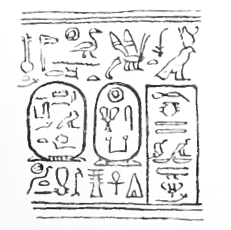
Merneferre Ay was an ancient Egyptian pharaoh of the mid 13th Dynasty. The longest reigning pharaoh of the 13th Dynasty, he ruled a likely fragmented Egypt for over 23 years in the early to mid 17th century BC. A pyramidion bearing his name shows that he possibly completed a pyramid, probably located in the necropolis of Memphis.

The Sixteenth Dynasty of ancient Egypt was a dynasty of pharaohs that ruled the Theban region in Upper Egypt for 70 years.

The Fourteenth Dynasty of Egypt was a series of rulers reigning during the Second Intermediate Period over the Nile Delta region of Egypt. It lasted between 75 and 155 years, depending on the scholar. The capital of the dynasty was probably Avaris. The 14th Dynasty existed concurrently with the 13th Dynasty based in Memphis. Some of the contested rulers of the 14th Dynasty are commonly identified by Egyptologists as being of Canaanite (Semitic) descent, owing to the distinct origins of the names of some of their kings and princes, like Ipqu, Yakbim, Qareh, or Yaqub-Har. Names in relation with Nubia are also recorded in two cases, king Nehesy and queen Tati. However, the dynasty rulers are not referred to as Hyksos in the Turin kings list.

Hor Awibre was an Egyptian pharaoh of the early 13th Dynasty in the late Middle Kingdom.

Sekhemkare Amenemhat V was an Egyptian pharaoh of the early 13th Dynasty during the Second Intermediate Period.
Renseneb Amenemhat was an Egyptian pharaoh of the 13th Dynasty during the Second Intermediate Period. According to egyptologist Kim Ryholt, Renseneb was the 14th king of the dynasty, while Detlef Franke sees him as the 13th ruler and Jürgen von Beckerath as the 16th. Renseneb is poorly attested and his throne name remains unknown.

Maaibre Sheshi was a ruler of areas of Egypt during the Second Intermediate Period. The dynasty, chronological position, duration and extent of his reign are uncertain and subject to ongoing debate. The difficulty of identification is mirrored by problems in determining events from the end of the Middle Kingdom to the arrival of the Hyksos in Egypt. Nonetheless, Sheshi is, in terms of the number of artifacts attributed to him, the best-attested king of the period spanning the end of the Middle Kingdom and the Second Intermediate period; roughly from c. 1800 BC until 1550 BC. Hundreds of scaraboid seals bearing his name have been found throughout the Levant, Egypt, Nubia, and as far away as Carthage, where some were still in use 1,500 years after his death.

Sekhemre Seusertawy Sobekhotep VIII was possibly the third king of the 16th Dynasty of Egypt reigning over the Theban region in Upper Egypt during the Second Intermediate Period. Alternatively, he may be a ruler of the 13th or 17th Dynasty. If he was a king of the 16th Dynasty, Sobekhotep VIII would be credited 16 years of reign by the Turin canon, starting c. 1650 BC, at the time of the Hyksos invasion of Egypt.

Ameny Qemau was an Egyptian pharaoh of the early 13th Dynasty in the late Middle Kingdom.

Sehetepibre Sewesekhtawy was an Egyptian pharaoh of the 13th Dynasty during the early Second Intermediate Period, possibly the fifth or tenth king of the Dynasty.

Nehesy Aasehre (Nehesi) was a ruler of Lower Egypt during the fragmented Second Intermediate Period. He is placed by most scholars into the early 14th Dynasty, as either the second or the sixth pharaoh of this dynasty. As such he is considered to have reigned for a short time c. 1705 BC and would have ruled from Avaris over the eastern Nile Delta. Recent evidence makes it possible that a second person with this name, a son of a Hyksos king, lived at a slightly later time during the late 15th Dynasty c. 1580 BC. It is possible that most of the artefacts attributed to the king Nehesy mentioned in the Turin canon, in fact belong to this Hyksos prince.
Iufni was an ancient Egyptian pharaoh of the 13th Dynasty during the Second Intermediate Period.
Sewadjkare was an Egyptian pharaoh of the 13th Dynasty during the early Second Intermediate Period.

Hotepibre Qemau Siharnedjheritef was an Egyptian pharaoh of the 13th Dynasty during the Second Intermediate Period.
Nedjemibre was an ephemeral Egyptian pharaoh of the 13th Dynasty of Egypt during the Second Intermediate Period reigning c. 1780 BC or 1736 BC.
Merkawre Sobekhotep was the thirty-seventh pharaoh of the Thirteenth Dynasty of Egypt during the Second Intermediate Period.

Sekhemkare Amenemhat Senebef was an Egyptian pharaoh of the early 13th Dynasty, often considered as the final part of the late Middle Kingdom or early Second Intermediate Period.

Sekhemraneferkhau Wepwawetemsaf was an Egyptian pharaoh during the Second Intermediate Period.

Sewahenre Senebmiu is a poorly attested Egyptian pharaoh during the Second Intermediate Period, thought to belong to the late 13th Dynasty.
Merkare was an Egyptian pharaoh of the late 13th Dynasty of Egypt during the Second Intermediate Period reigning for a short while, some time between 1663 BC and 1649 BC.
















